THE THEATRE ORGAN
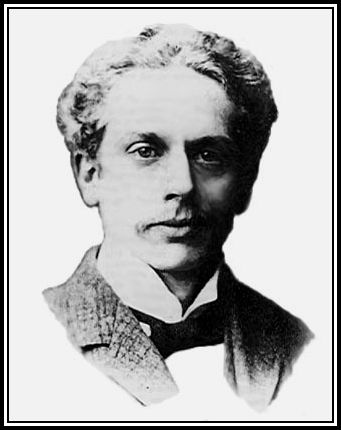 Robert Hope-Jones (1859-1914), Father of The Theatre Organ
Robert Hope-Jones (1859-1914), Father of The Theatre Organ
PART TWO: BUILDERS OF THE THEATRE ORGANS
THIS PAGE IS WRITTEN IN CONJUNCTION WITH GLEN TWAMLEY (FRIENDS OF BEER WURLITZER)
-oOo-
PAGE THREE: DECORATION of THE WURLITZER ORGAN CONSOLE
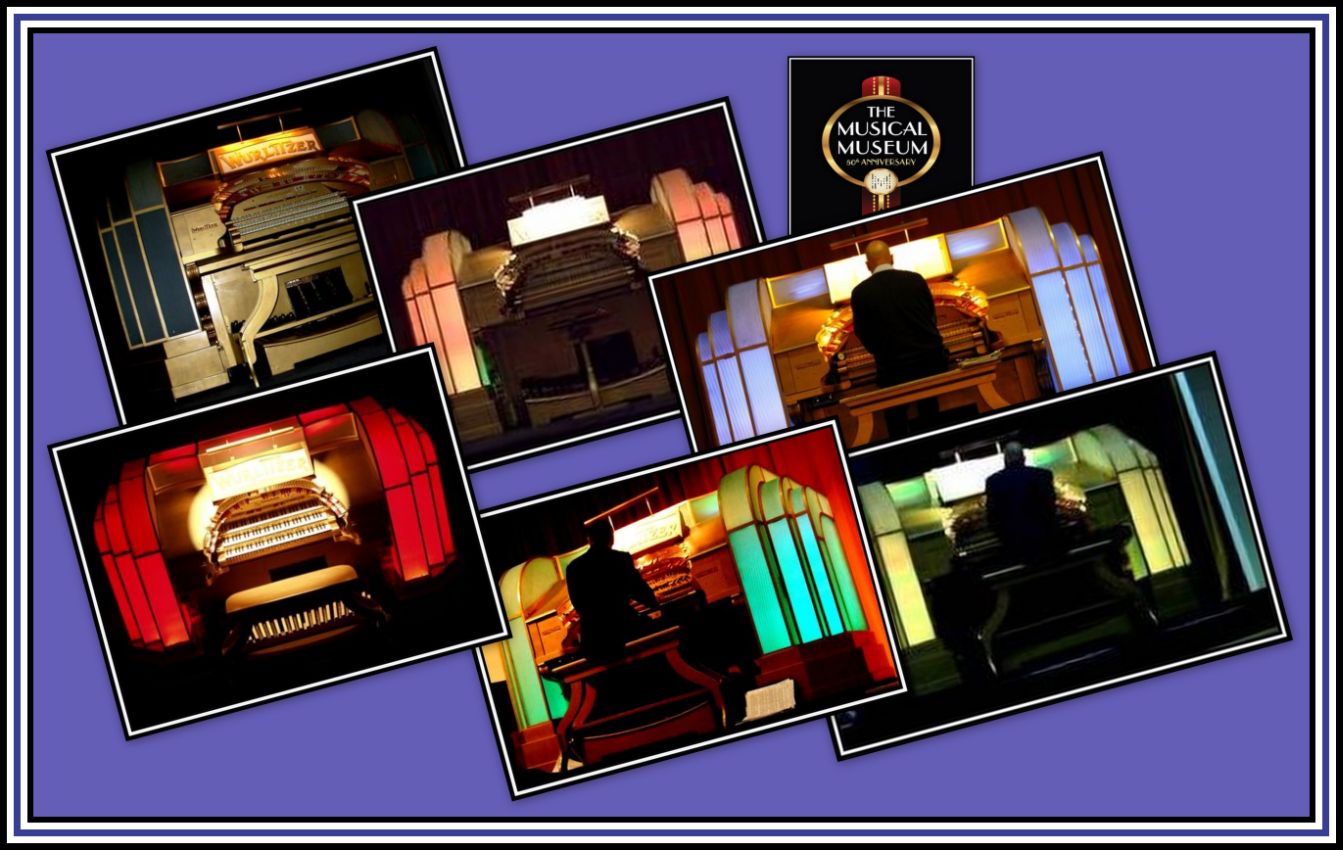 Click here to see & hear the Wurlitzer Organ at the Musical Museum Brentford
Click here to see & hear the Wurlitzer Organ at the Musical Museum Brentford
Until recently, I shared the idea along with the majority of people that the Theatre Organ was THE CONSOLE and nothing more. After all, this was all I saw once it that rose up from beneath the orchestra pit and seemed to be where that amazing sound was produced when the organist played the notes, right? Like many others, I had no idea that hidden away in one or two cavernous spaces, called chambers, generally tucked away behind fancy grillwork adjacent to the Proscenium of the stage, were the Ranks or rows of pipes, along with a multitude of percussion instruments and novelty effects, that emitted the dulcet sounds that we heard in the auditorium.
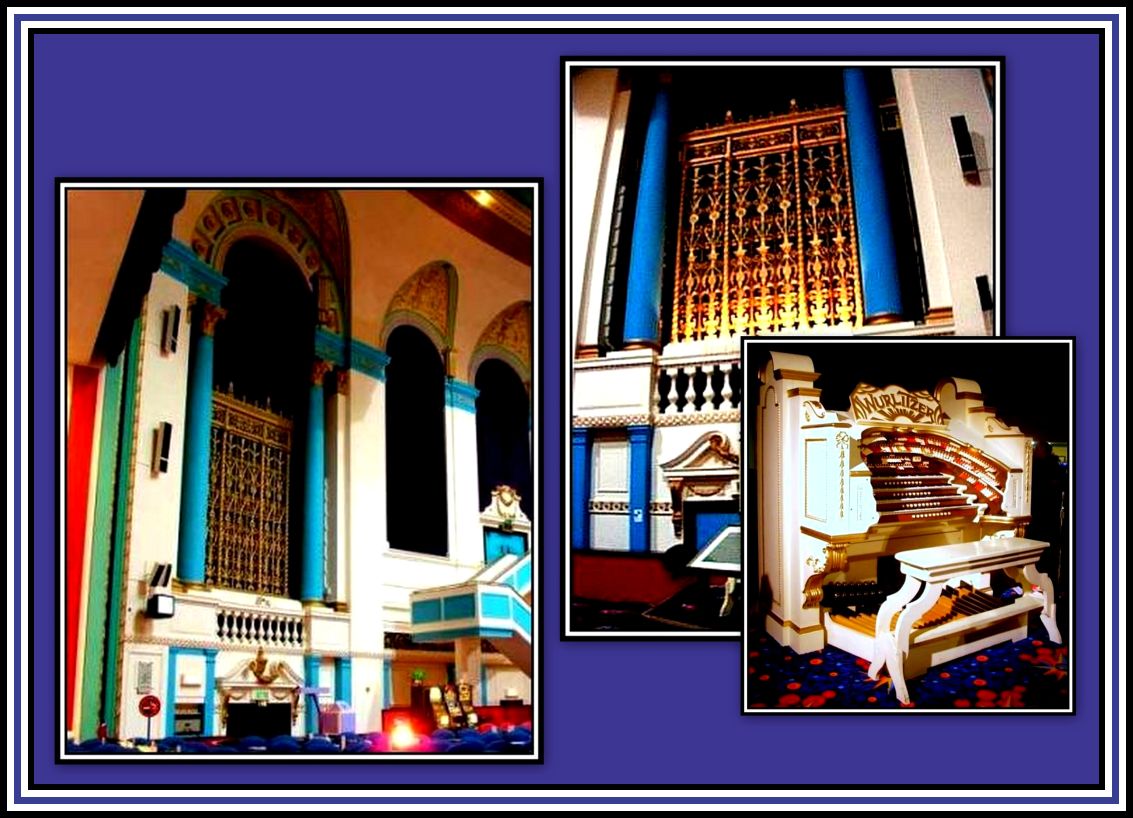 Grillwork & Wurlitzer Organ of the former Gaumont State Kilburn
Grillwork & Wurlitzer Organ of the former Gaumont State Kilburn
-oOo-
When Theatre Organs were first introduced into Picture Houses during the early to mid-1920s, their purpose was to accompany silent films and help create a mood to support the action being shown on the screen. At this time, the consoles were often hidden away in orchestra pits and out of sight of the audience. As a result, the consoles tended to be plain with perhaps a paneled design and finished in dark, natural wood colours.
 The Console of New Gallery Cinema – note the absence of decoration
The Console of New Gallery Cinema – note the absence of decoration
When talking pictures arrived in 1929, the primary function of the Theatre Organ changed. No longer needed to support the action on the screen, many Picture Houses in the U.S. were quickly removed and either sold or broken up. Some fortunately found their way to the U.K. where they were installed and gave pleasure to the cinema-going public for many years.
Those that remained in the U.S. and elsewhere were now employed to provide musical interludes between programmes, as accompaniment to other musicians and singers and for solo spots. Now that the organ’s primary function had changed and was now at times the centre of the audience’s attention, there became a greater need for the consoles to be visible. To allow the console and the organist to be seen throughout the auditorium, they were placed on lifts that allowed them to rise up from the orchestra pit where they were bathed by limelight, thereby giving them, and the organists, an elevated status in the programme.
As a result of the Theatre Organ’s new position of importance, the console began to take on a grander. Gone now were the dark wood colours of the early consoles and replaced by more eye-catching bright colours and designs, such as cream or white with gold trimmings.
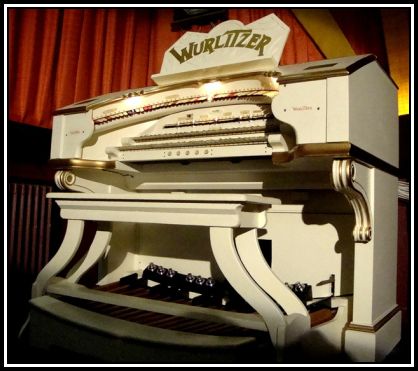 The erstwhile Wurlitzer Organ of the Rex Cinema Stratford now restored and installed at the Royalty Cinema Bowness-on-Windermere – note the console colour and the presence of some gold trim
The erstwhile Wurlitzer Organ of the Rex Cinema Stratford now restored and installed at the Royalty Cinema Bowness-on-Windermere – note the console colour and the presence of some gold trim
A style of console decoration that was most popular was the so-called French Style that was characterised by curved additions to the sides along with gold trim. In the following collage, the two manual-console on the left, which is now installed at the The Burtey Fen Collection, Lincs. , came from the Regent Cinema Ipswich while the pipework of the organ came from the Gaumont Cinema Exeter (the console of this organ was destroyed by bombing in 1942). The three-manual console on the right is the original installed with the organ at the Empress Ballroom Blackpool. Upon it removal from the Ballroom, it was put into storage, but has since been restored and was displayed at Wolverhampton for a while, but has since been returned to storage
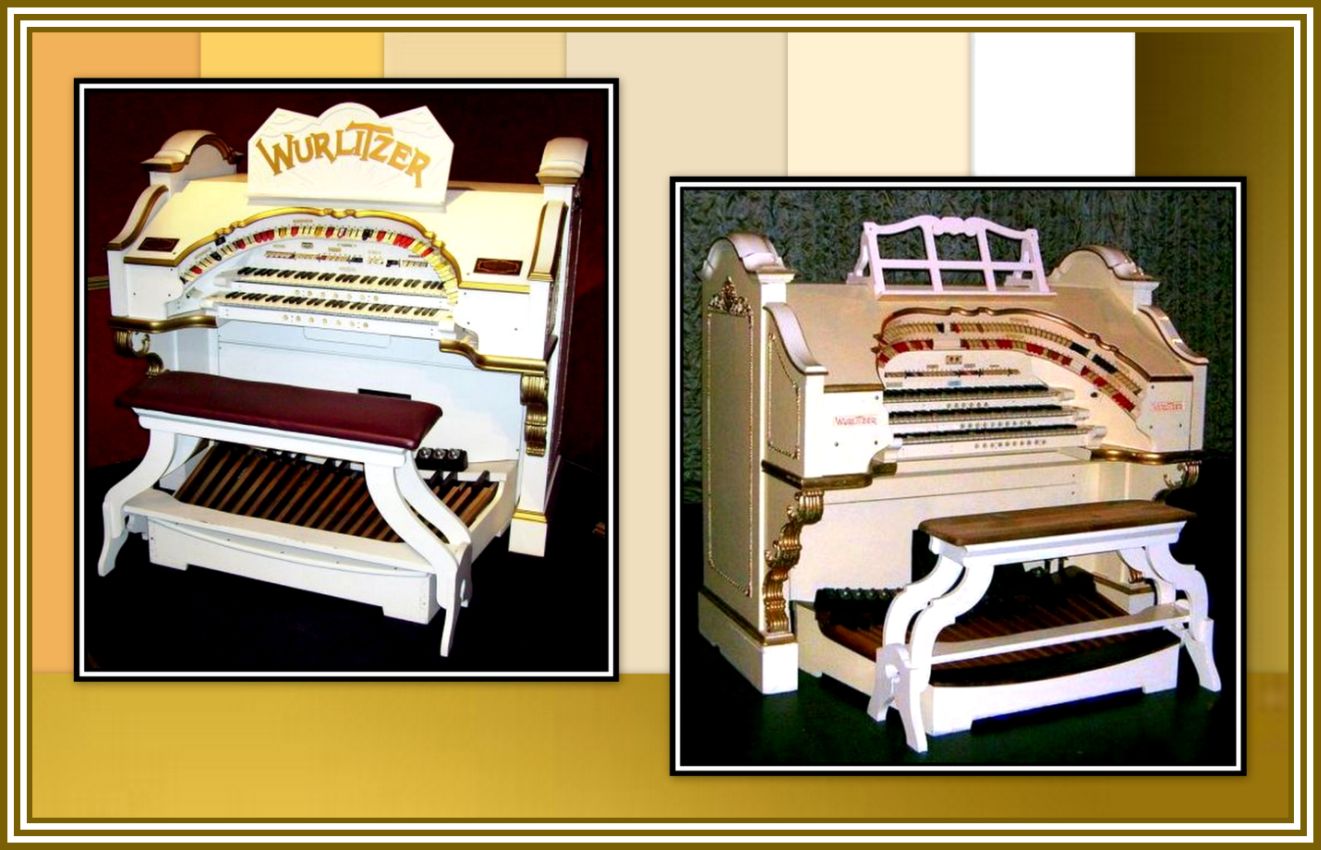 Wurlitzer French Style Theatre Organ Consoles
Wurlitzer French Style Theatre Organ Consoles
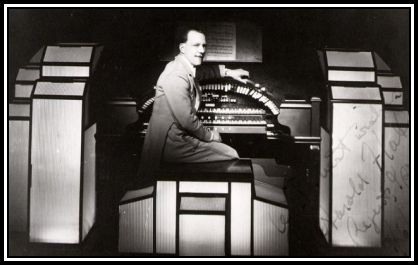 Harold Flatman at the 2-Manual Console at the Regent Cinema Ipswich
Harold Flatman at the 2-Manual Console at the Regent Cinema Ipswich
In many instances, especially in the U.S., the console became decorated in an extreme and oftentimes overly glamorous manner that was extremely elaborate and glitzy. This trend is best exemplified by The Wurlitzer Organ Console of The Alabama Theater in Birmingham, Alabama and the erstwhile Chicago Stadium Barton Console Pipe Organ, the largest theatre organ console built, now installed in a private home in the U.S.
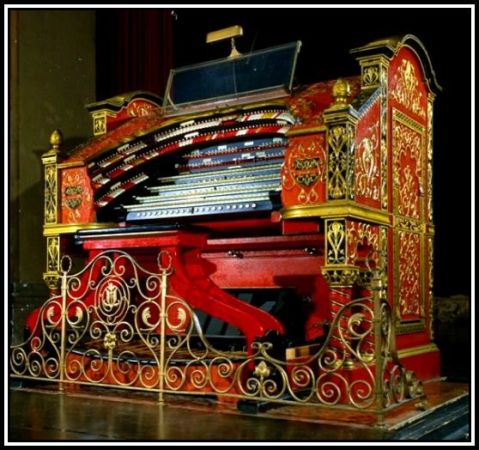 The Publix-1 Style Console of the Wurlitzer Organ (4 Manuals & 28 Ranks) installed at The Alabama Theater Birmingham
The Publix-1 Style Console of the Wurlitzer Organ (4 Manuals & 28 Ranks) installed at The Alabama Theater Birmingham
Click here to hear this organ played – known as Big Bertha
Stars Fell on Alabama played by Cecil Whitmore on the Organ of The Alabama Theater Birmingham
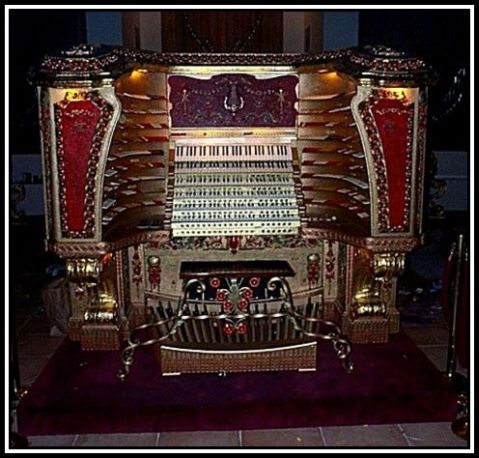 The Console of the Barton Organ (6 Manuals & 52 Ranks) of the former Chicago Stadium
The Console of the Barton Organ (6 Manuals & 52 Ranks) of the former Chicago Stadium
Click here to hear this organ being played
-oOo-
A number of cinema circuits developed their own characteristic console style for organs installed in their cinemas. In the mid-1930s, James Morrison, the house architect of The Granada Theatre Circuit, designed a console specific to the circuit. His design was easily recognisible by the flat box ends style, which was used in some thirteen Wurlitzer Organs consoles installed in Granada Theatres.
The first Granada Theatre Organ with the Morrison-style console was installed at the Granada Theatre Bedford in 1934. This particular organ, which had 3-manuals and 8-ranks, was adapted from the Wurlitzer Organ Style-190 and was sold as a 190 “Special”.
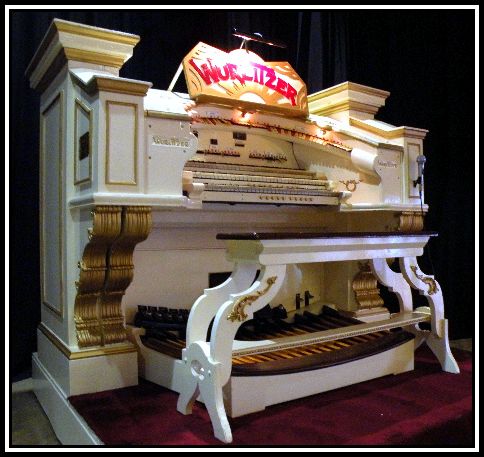 The Wurlitzer Organ of the Granada Theatre Bedford, which was installed at Redcar Pier, but removed in 1981 and re-installed at the James Finegan Municipal Hall, Eston, which was demolished in July 2012.
The Wurlitzer Organ of the Granada Theatre Bedford, which was installed at Redcar Pier, but removed in 1981 and re-installed at the James Finegan Municipal Hall, Eston, which was demolished in July 2012.
-oOo-
In 1935, a larger version of the Granada-style Organ with four manuals and 14 ranks of pipes was built for installation at the Granada Theatre at Manchester, which was sold to Gaumont British Cinemas the day before its official opening.
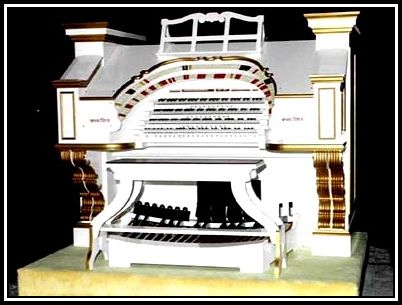 The 4-Manual Wurlitzer Console of the Gaumont Cinema Manchester – this photograph appears here with the permission of Mr. David Allfred, The Lancastrian Theatre Organ Trust
The 4-Manual Wurlitzer Console of the Gaumont Cinema Manchester – this photograph appears here with the permission of Mr. David Allfred, The Lancastrian Theatre Organ Trust
The Organ was considered to be one of the best instruments in the U.K. and when it was removed from its original site of installation, it was brought to the Baronial Hall of Granada Studios where it remained for eight years until its closure. The Organ was next stored for seven years before being sold to Folly Farm in South Wales and was opened to the public in May 2009 by John Mann.
Click here to hear this Organ being played by Chris Mannion
-oOo-
Once the design of the console and organ was finalised by the Wurlitzer Organ Company and Granada Theatre Limited, production began. This style, known as Gran-1, consisted of 3-manuals and 8-ranks, which included trumpet, open diapason, tibia, clarinet, violin, violin celeste, flute and vox humana.
In 1936, four of these instruments were produced and installed at the Granada Theatres in Mansfield, Wandsworth, East Ham and Woolwich.
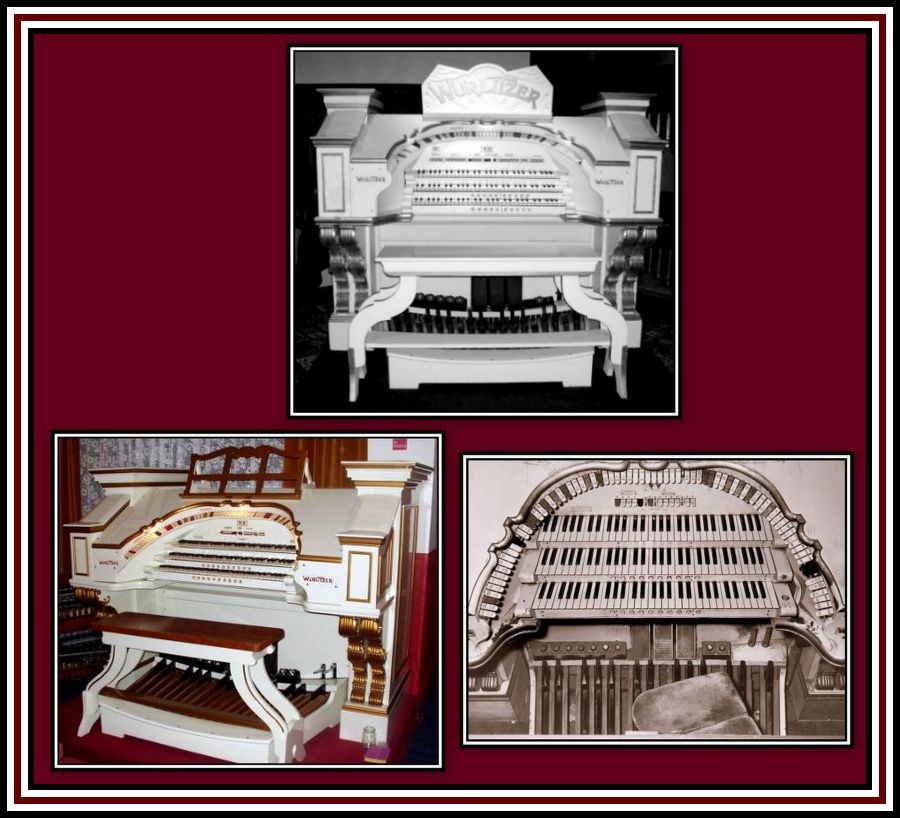 The Console of the Gran-1 Style Wurlitzer Organ installed at the Granada Mansfield (Top) and that of the Wurlitzer Ogan of the Granada Theatre East Ham (Bottom).
The Console of the Gran-1 Style Wurlitzer Organ installed at the Granada Mansfield (Top) and that of the Wurlitzer Ogan of the Granada Theatre East Ham (Bottom).
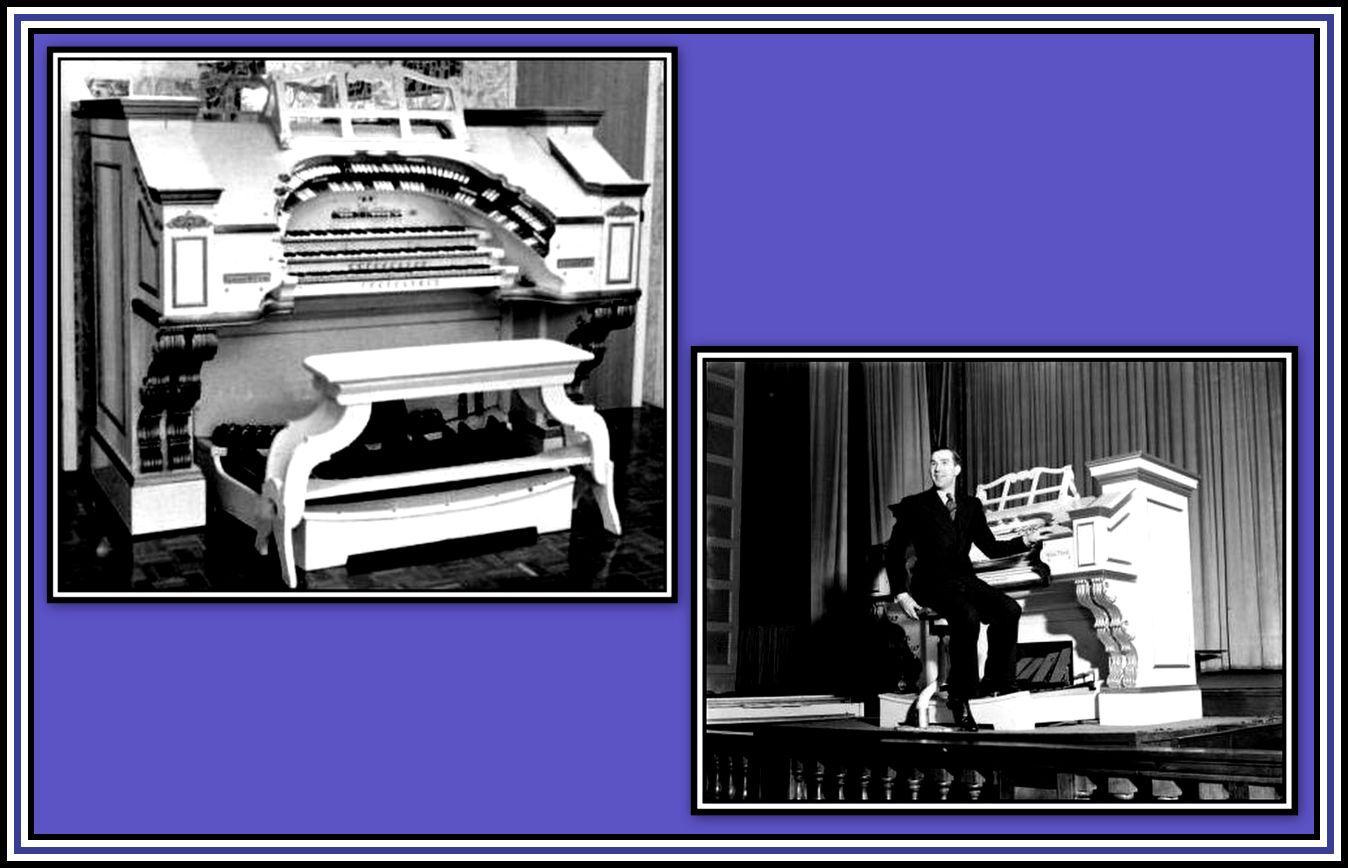 The Console of the Gran-1 Style Wurlitzer Organ of the Granada Theatre Wandsworth, which was once the property of Mr. Les Rawle and is now currently installed in a private home. The console is seen here with Robinson Cleaver
The Console of the Gran-1 Style Wurlitzer Organ of the Granada Theatre Wandsworth, which was once the property of Mr. Les Rawle and is now currently installed in a private home. The console is seen here with Robinson Cleaver
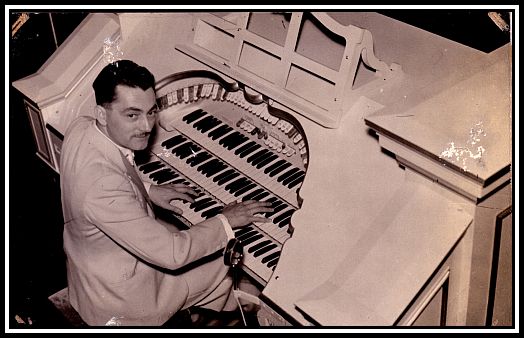 Reginald Dixon at the Wurlitzer Organ (Gran-1 Style) of the Granada Theatre Woolwich, which he opened. The organ is currently installed at Tywyn, Gywnedd
Reginald Dixon at the Wurlitzer Organ (Gran-1 Style) of the Granada Theatre Woolwich, which he opened. The organ is currently installed at Tywyn, Gywnedd
-oOo-
In 1937, Granada Theatre Limited asked to have some slight changes made to the specifications for future Wurlitzer Organs, which included the addition of Jazzier Reed stops. This led to the production of the Granada Gran-2 Style Organs. Here, changes were also made to the console, which now gave it a sleeker frontal appearance. In addition, a number of pipes were added to the organ specifications, which included the English horn, tuba horn, open diapason, tibia, saxophone, gamba, gamba celeste and flute.
Six Granada Gran-2 Style Organs were installed in the U.K. at the Granada Theatres at North Cheam, Harrow, Clapham, Greenford, Welling and Slough.
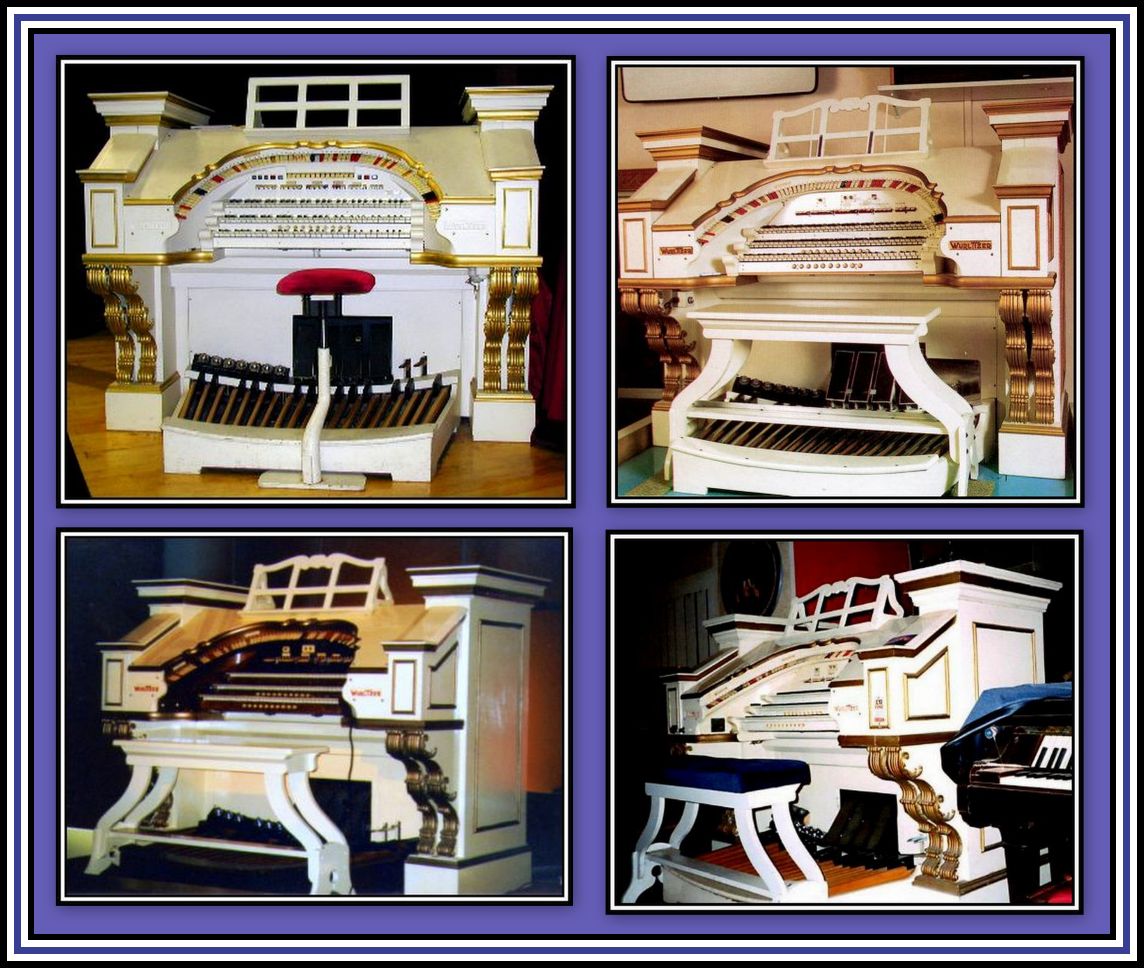 Consoles of the Gran-2 Style Wurlitzer Organs installed at the Granada Theatres at: Top, Clapham (Left) and Greenford (Right) and Bottom, Harrow (Left) and North Cheam (Right).
Consoles of the Gran-2 Style Wurlitzer Organs installed at the Granada Theatres at: Top, Clapham (Left) and Greenford (Right) and Bottom, Harrow (Left) and North Cheam (Right).
Click here to hear and see Miss Ena Baga play the Granada Theatre Harrow Wurlitzer Organ
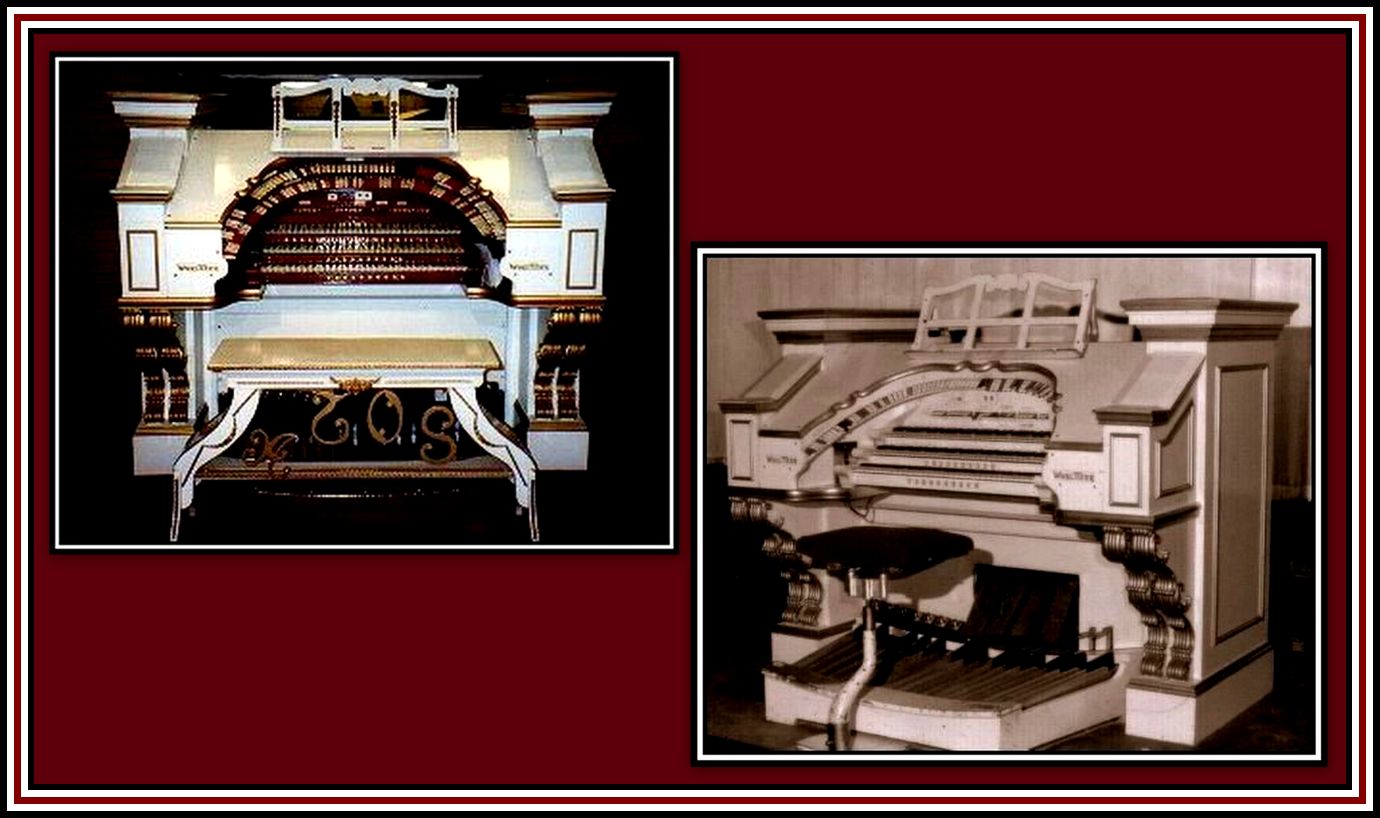 Consoles of the Gran-2 Style Wurlitzer Organs installed at the Granada Theatres at : Left, Welling (now installed at the Woking Leisure Centre) and Right, Slough (now installed in a private home)
Consoles of the Gran-2 Style Wurlitzer Organs installed at the Granada Theatres at : Left, Welling (now installed at the Woking Leisure Centre) and Right, Slough (now installed in a private home)
-oOo-
The Theatre Organ installed at the Granada Theatre Greenwich was an earlier 3-8c specification of the Wurlitzer Theatre Organ and complete with Clarinet and Vox, and presently, it is in storage.
-oOo-
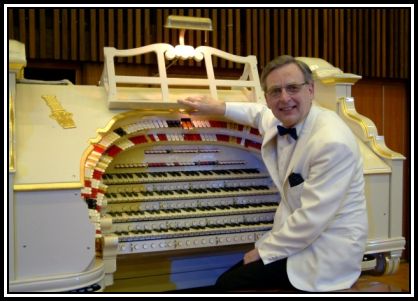 Len Rawle at the erstwhile Trocadero Cinema, Elephant & Castle when it was installed at South Bank University; this Theatre Organ has since been installed at the Troxy, Commercial Road, Stepney
Len Rawle at the erstwhile Trocadero Cinema, Elephant & Castle when it was installed at South Bank University; this Theatre Organ has since been installed at the Troxy, Commercial Road, Stepney
-oOo-
Click here to hear the erstwhile Wurlitzer Organ of the Granada Theatre Slough
-oOo-
Barney Balaban together with his brother-in-law, Sam Katz, formed the Balaban & Katz Theatre Chain in 1916 in Chicago and opened their first cinema, the Central Park Theatre, in 1917, the first to have air-conditioning albeit rudimentary. Balaban & Katz built their cinemas in the suburbs of the growing cities in order to capture the middle class audience that was moving there, as well as in the centre of Chicago. The Corporation built a number of Picture Palaces with elaborate decoration and became renowned for the accompanying lavish stage shows.
In 1926, Famous Players-Lasky Corporation, which was the forerunner of Paramount Pictures purchased a controlling interest in the Balaban & Katz Theatre Chain in exchange for stock. Sam Katz became president of The Publix Theaters Chain, a division of Famous Players-Lasky Corporation and in 1936 Barney Balaban became president of Paramount Pictures, a position he held until 1964. In 1939, Balaban & Katz together with Paramount Pictures became interested in the development of television broadcasting and in 1943 began broadcasting the first commercial television station in Chicago, WBKB, now WBBM-TV.
The cinemas built by Balaban & Katz were highly decorative and imaginative in design. A number of their Picture Palaces including the Chicago Theater, Gateway Theater, Uptown Theater and many Paramount Theaters across the Mid-West and other areas of the U.S. were decorated with murals, which Balaban & Katz commissioned painter and muralist Louis Grell to execute.
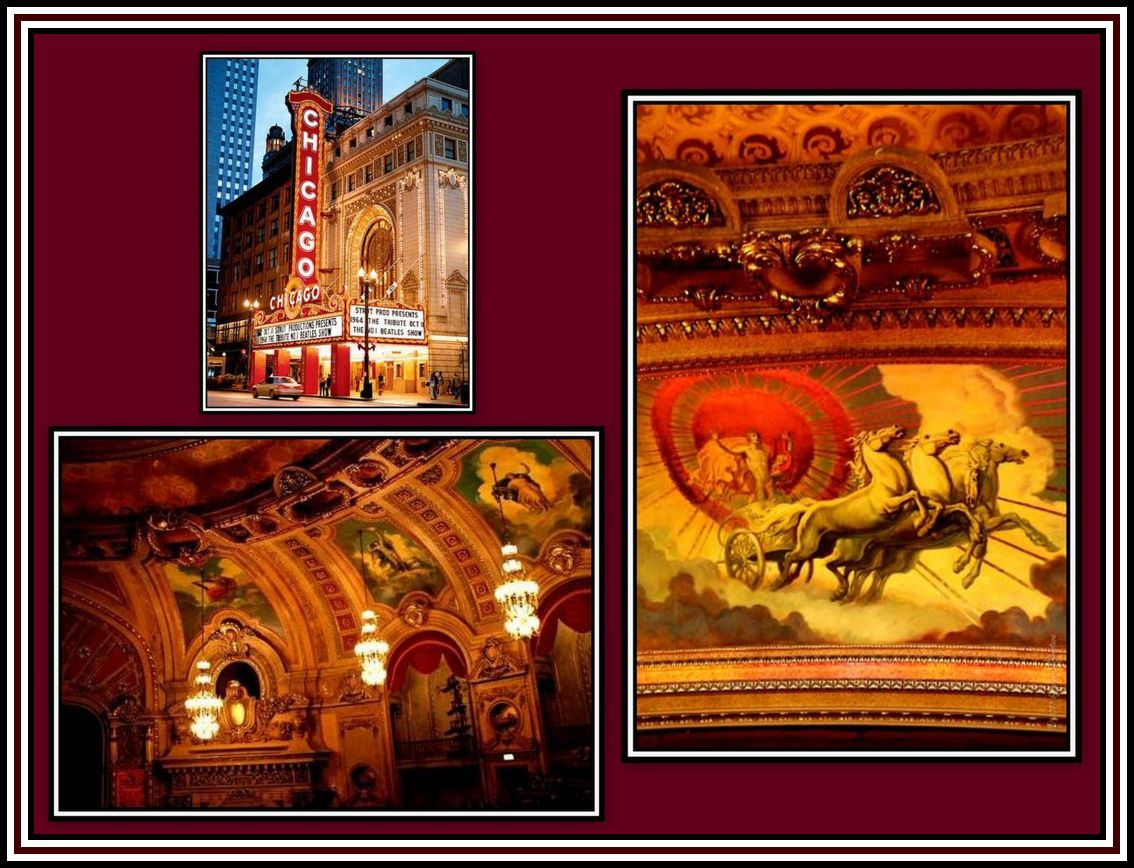 Murals of The Chicago Theater, known as The Wonder Theater of the World
Murals of The Chicago Theater, known as The Wonder Theater of the World
Many of their more prestigious theatres were installed with Theatre Organs where the consoles were of a style developed by the company. The Wurlitzer Organ Company referred to the design as their modernistic console. The Chicago Theater opened in 1921 and was installed with a Wurlitzer Theatre Organ with 29 ranks, which was opened by Jesse Crawford.
Click here to hear Jesse Crawford, the Poet of the Organ, play
Apparently each console constructed by The Wurlitzer Organ Company for Balaban & Katz was one of four styles: BAL1, BAL2, BAL3 and BAL4. However each console differed little. Two consoles of the Balaban & Katz design were exported to the U.K. and were installed at the Paramount Cinema Leeds and at the Paramount Cinema Newcastle. Paramount Theatres Limited had built seven cinemas in the U.K., which were taken over by Odeon Cinemas Limited in 1939 and renamed in 1940.
The consoles that were exported to the U.K. were both of the BAL4 Style. The organ (3 Manuals, 19 ranks) installed at the Paramount/Odeon Leeds was removed from the cinema during the mid-1960s and is now installed at The Thursford Collection where Robert Wolfe is resident organist.
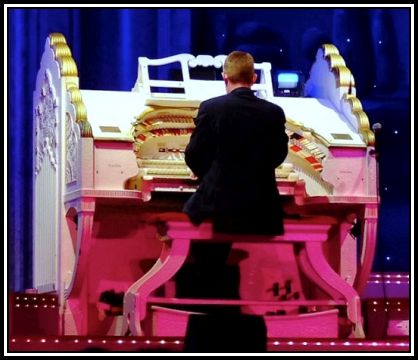 Click here to hear Robert Wolfe playing this organ
Click here to hear Robert Wolfe playing this organ
The organ of the Paramount/Odeon Cinema Newcastle (3 manuals, 19 ranks) went to Turner’s Musical Merry-go-Round. When Turner’s Musical Merry-go-Round closed, the organ was taken into storage and is currently awaiting a suitable home.
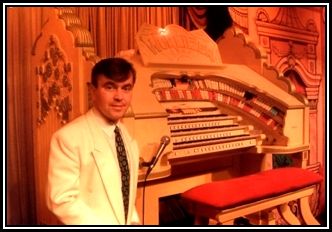 The only photograph of Turner’s Wurlitzer Organ that I have been able to find – this is a CD cover showing the organist Nick Martin
The only photograph of Turner’s Wurlitzer Organ that I have been able to find – this is a CD cover showing the organist Nick Martin
Balaban & Katz had another series of designs for Theatre Organ consoles, which was known collectively as Publix. The consoles and organs were built by The Wurlitzer Organ Comapny and were originally installed in the theatres of the Paramount-Publix Chain in the U.S. The console of Big Bertha, the Wurlitzer Organ installed at The Alabama Theater Birimingham was of the Publix-1 Style (see above for illustration).
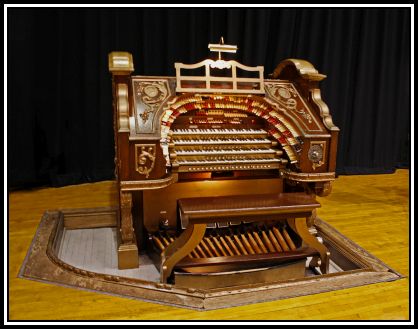 The Publix-4 Style Console of the Wurlitzer Organ of the Brooklyn Paramount Theater. There were two such consoles produced: the second, once installed at Metropolitan Theater Boston, has since been broken up.
The Publix-4 Style Console of the Wurlitzer Organ of the Brooklyn Paramount Theater. There were two such consoles produced: the second, once installed at Metropolitan Theater Boston, has since been broken up.
One of these models was originally installed at the Paramount Theatre in Manchester. In 1977, the organ was moved to Manchester’s Free Trade Hall where it remained until 1999 when The Hall was closed for conversion into a hotel. The organ was removed and is now currently at Stockport Town Hall.
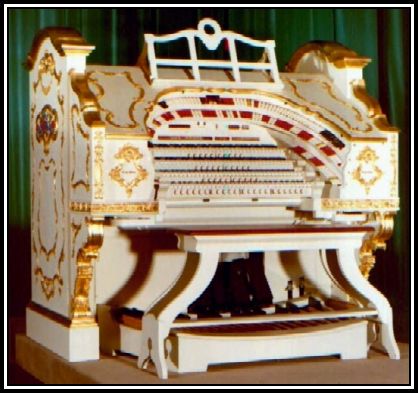 The Stockport Town Hall Wurlitzer Organ
The Stockport Town Hall Wurlitzer Organ
Click here to see and hear the Stockport Town Hall Wurlitzer Organ (4 manuals, 20 ranks)
-oOo-
Union Cinemas was a cinema circuit in the U.K. that was founded by David Bernhard. However, before turning his attention to cinemas, Mr. Bernhard had entered the fields of film distribution and production by financing British Exhibitor Films Limited (B.E.F.) in 1922 and helping to set up Bernhard-Tiffany Productions in 1924. These companies were later amalgamated and B.E.F. became the distributor of the films made the production company.
With the advent of talkies, Mr. Bernhard quickly realised the potential of cinema entertainment. As a result, he turned his attention to cinemas themselves and in 1928 acquired seven cinemas and set up Union Cinema Co. Ltd. Initially Mr. Bernhard had planned to produce films to be shown in Union Cinemas, but soon left production to concentrate on the development of the cinema chain. Within a few years, Union Cinemas were to be found throughout the U.K. and chose names like Ritz, Regal, Embassy etc for them. There was to be 136 cinemas in the Union Cinema Chain.
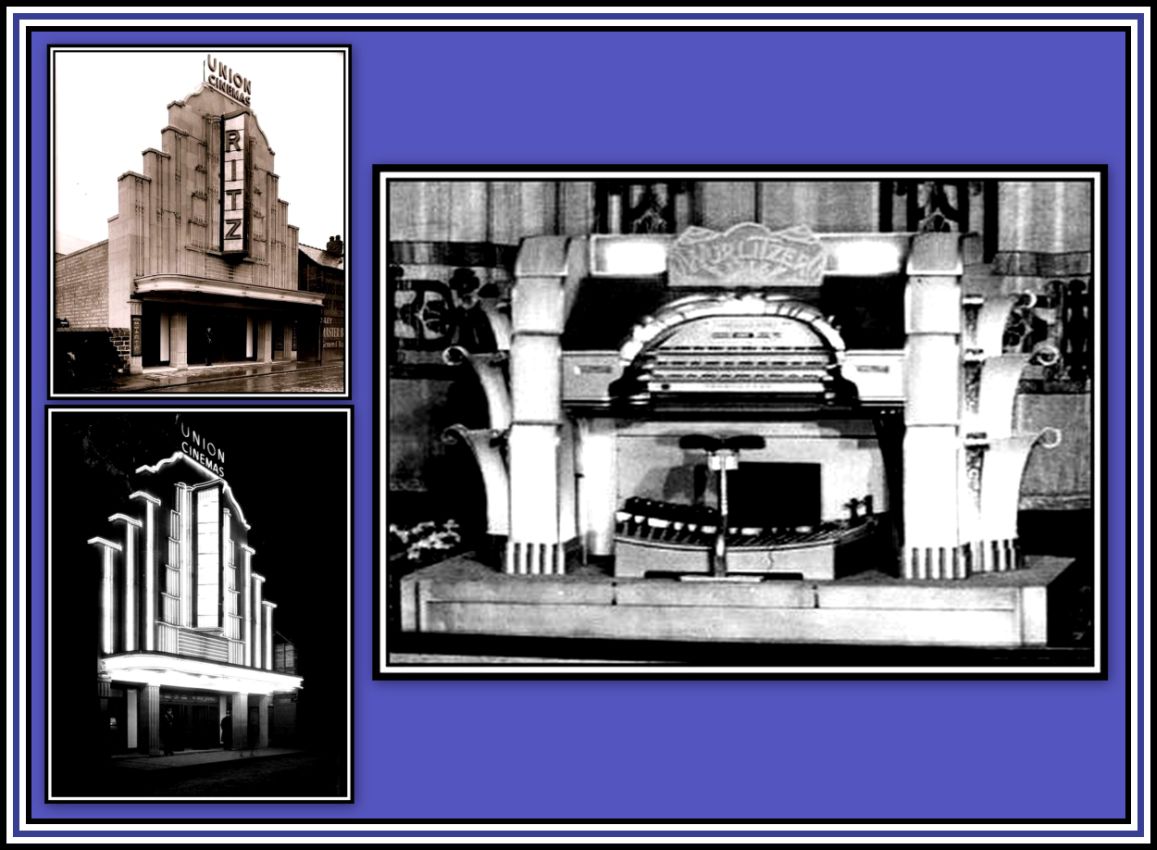 Ritz Cinema Barnsley & its Wurlitzer Organ
Ritz Cinema Barnsley & its Wurlitzer Organ
In 1937, Union Cinemas were experiencing managerial and financial difficulties. The Circuit was renowned for its presentation of live shows (Cine Variety), which it was now forced to cut back on. The situation came to a head with the death of Mr. Bernhard and, by the end of the year, Union Cinemas went into receivership. Early in 1938, the Associated British Picture Corporation had taken over each of the Union Cinemas and began phasing out Cine Variety.
 -oOo-
-oOo- 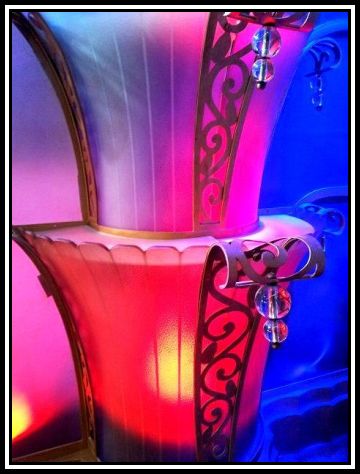 Pillar-and-Vase Surround Design specific to the Union Cinema Circuit
Pillar-and-Vase Surround Design specific to the Union Cinema Circuit
Many of the Union Cinemas of the 1930s were installed with Wurlitzer Organs. The consoles were especially made for its Cinema Circuit to specific designs of which there were at least three: UNN1, UNN2 and UNN3.
Although Union Cinema organ consoles appear to be the most elaborate than those of other cinema circuits, they were in fact standard box-like structures much like earlier models and painted with gold paint, but it was the addition of illuminated surrounds that made them look fancy. The first consoles produced had illuminated rainbow-style surrounds, which had been popularised earlier by Compton Organs.
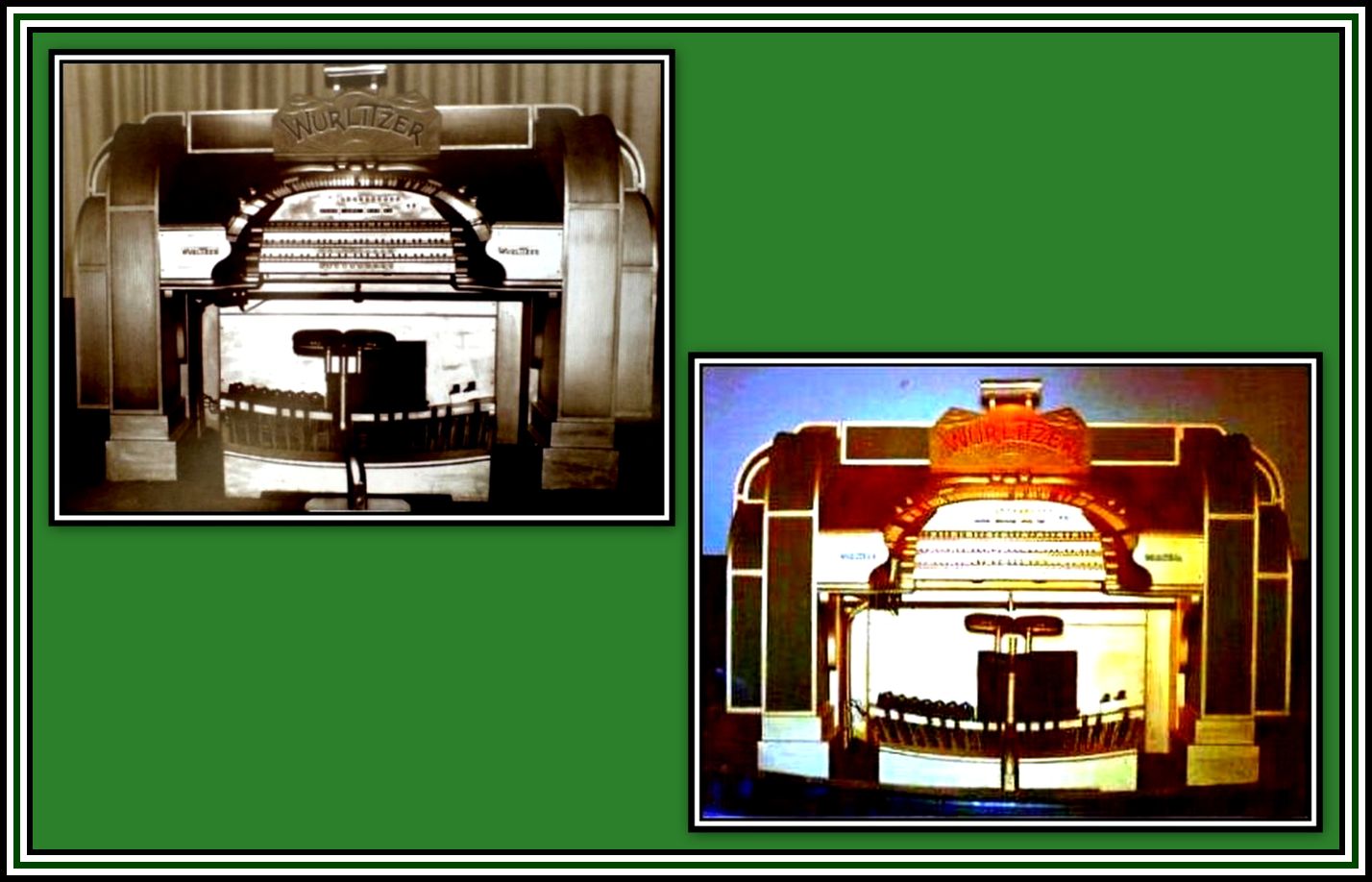 The Wurlitzer Console installed at the Ritz Cinema Ipswich
The Wurlitzer Console installed at the Ritz Cinema Ipswich
Later Union Cinemas installed consoles with an illuminated pillar-and-vase design, which had been built by R.R.Beard Limited in its factory in South London. A number of the examples were dubbed jelly moulds, as a result of the shapes of the surrounds. Seemingly the heat from the illumination, which was no doubt intensified should the organ bench also be illuminated, as it was at the Embassy Cinema Maldon. This caused organists to refer to it as The Hot Seat. The concept of illuminated surrounds proved to be a feature unique to British consoles and was not employed in the U.S. or elsewhere.
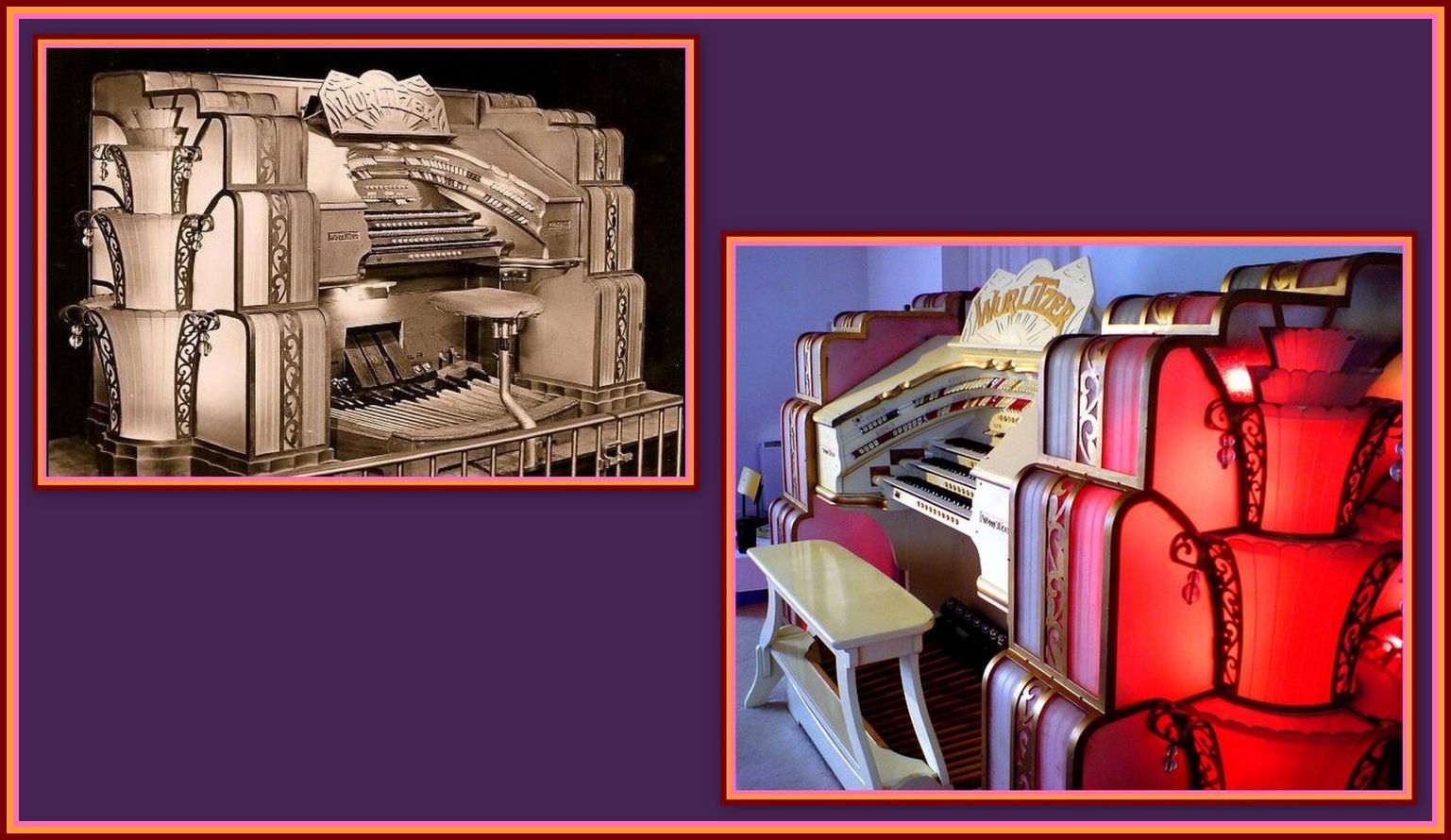 The Pillar-and-Vase Console of the Wurlitzer Organ installed at the Ritz Cinema Luton
The Pillar-and-Vase Console of the Wurlitzer Organ installed at the Ritz Cinema Luton
-oOo- 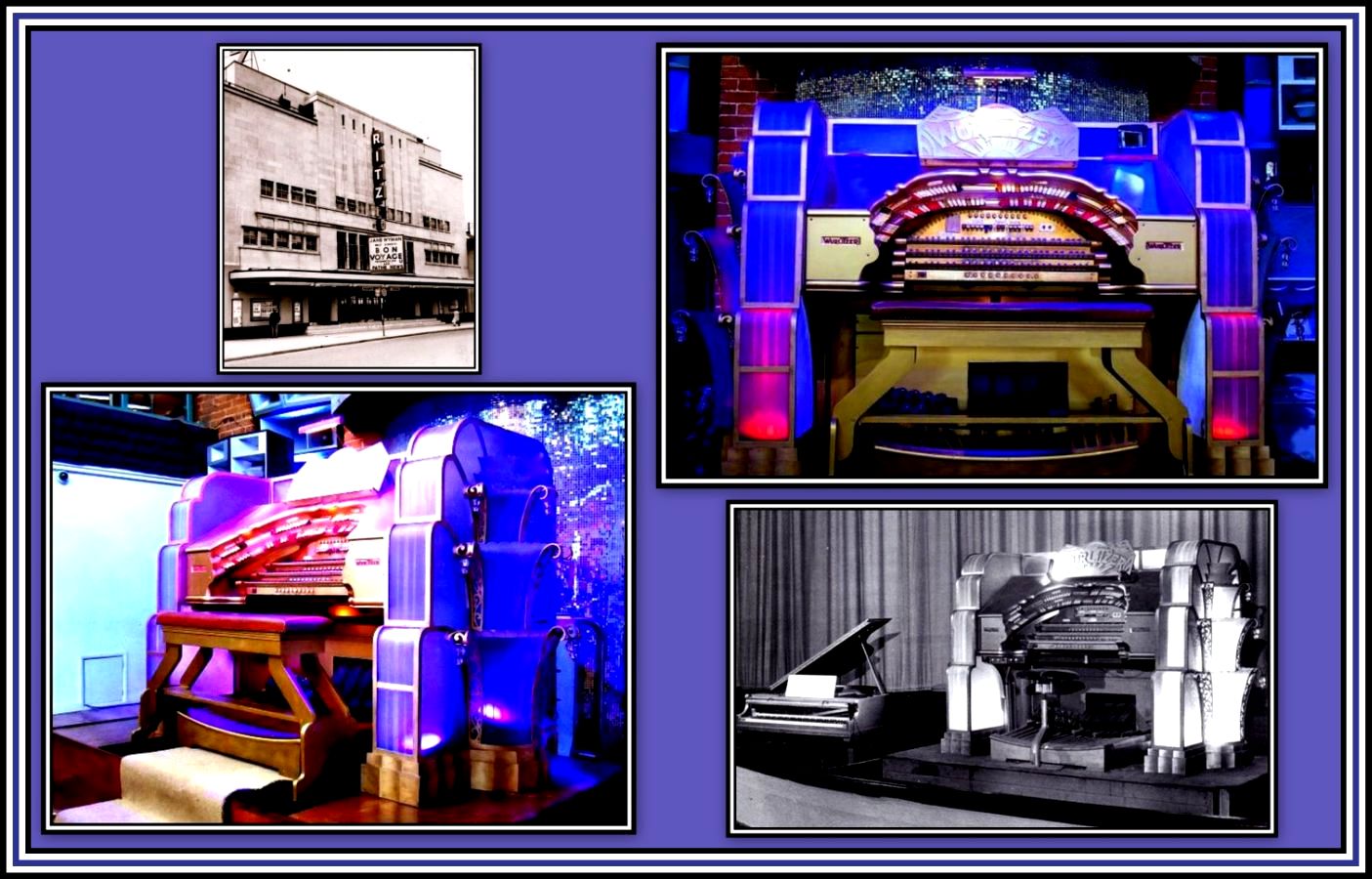 The Pillar-and-Vase Console of the Wurlitzer Organ originally installed at the Ritz Cinema Chatham and now installed at Buttermarket. The photographs of the Buttermarket Wurlitzer appear with permission of the Buttermarket Shrewsbury.
The Pillar-and-Vase Console of the Wurlitzer Organ originally installed at the Ritz Cinema Chatham and now installed at Buttermarket. The photographs of the Buttermarket Wurlitzer appear with permission of the Buttermarket Shrewsbury.
We are not clear as to what were the specifications that designated an organ, as either UNN1, UNN2 or UNN3. The early 8-rank organs were probably of UNN1 design and the two 7-rank organs were perhaps UNN2. We are unsure what features distinguished these from UNN3 organs since we are not in possession of the specifications. It is possible that the organ installed in the Union Cinemas at Chatham, Hastings, Luton, Richmond and Stockport were of the UNN3 type, but we cannot say this for certain at this time.
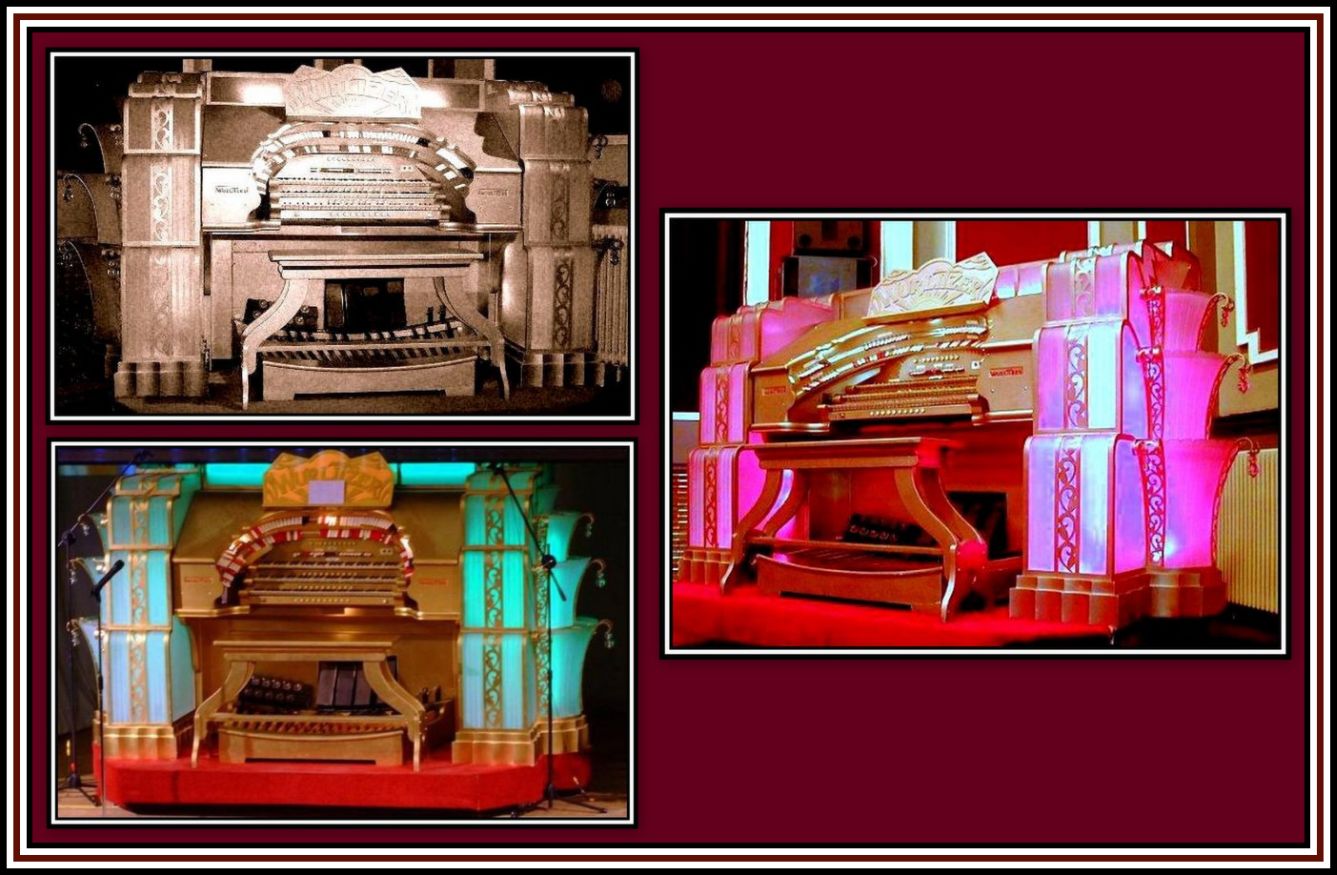 The Pillar-and-Vase Console of the Wurlitzer Organ originally installed at the Ritz Cinema Stockport and now installed at Polloshaws Burgh Hall
The Pillar-and-Vase Console of the Wurlitzer Organ originally installed at the Ritz Cinema Stockport and now installed at Polloshaws Burgh Hall
If a reader has any information regarding the classification, please contact us.
-oOo-
A number of unique consoles were made by The Wurlitzer Organ Company for installations along with their organs to fulfill a customer’s specific needs. For example, the console of the organ of the Gaumont State Kilburn was narrower than the normal specification for its model since it was required to fit on a turntable/lift.
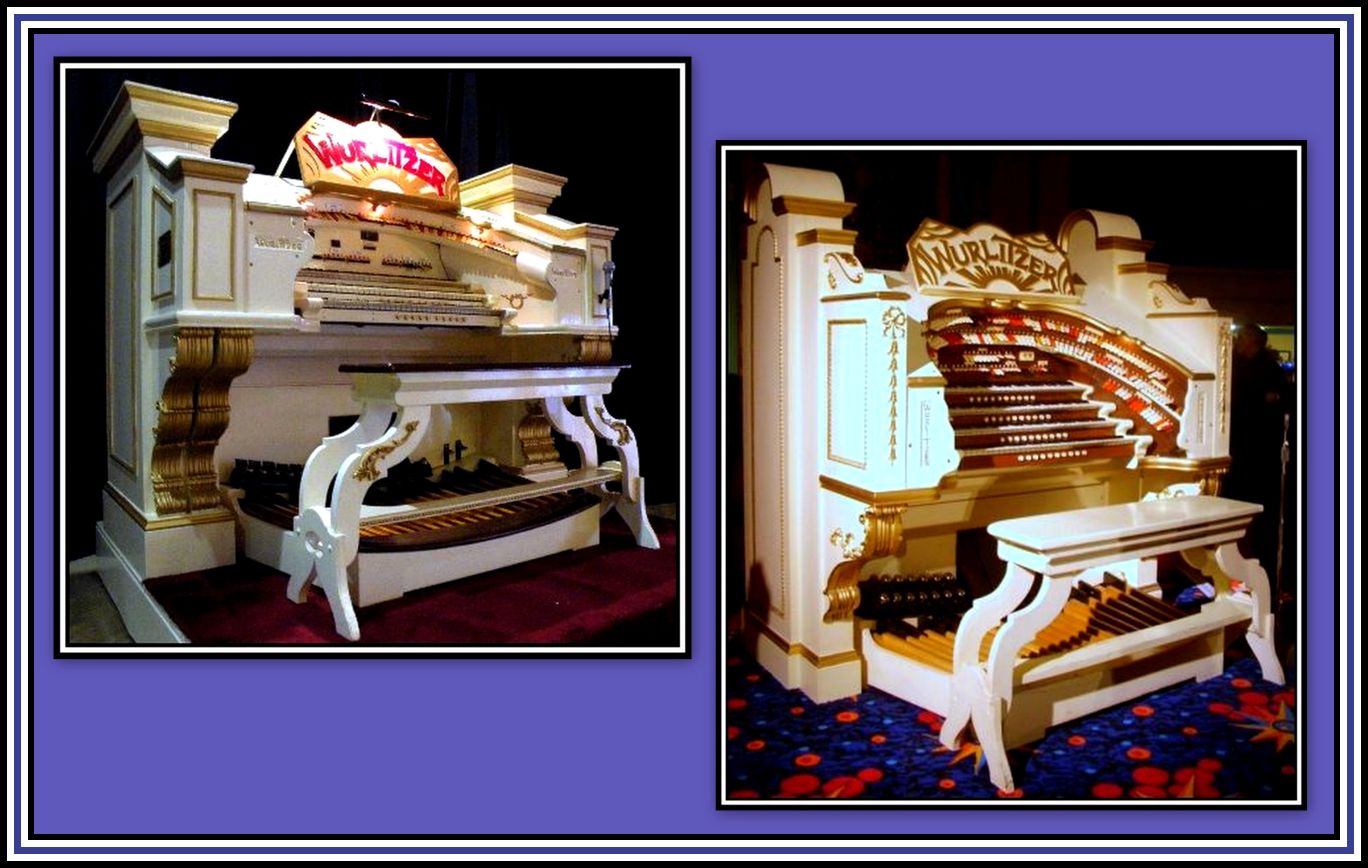 Comparision of a the 190 “Special” installed at the Granada Theatre Bedford (Left) with the Console of the Gaumont State Kilburn (Right) where the differences in width may readily be seen.
Comparision of a the 190 “Special” installed at the Granada Theatre Bedford (Left) with the Console of the Gaumont State Kilburn (Right) where the differences in width may readily be seen.
Gaumont British Cinemas, owners of the Gaumont State Kilburn, ordered a copy of this narrower console model and had it installed together with its organ (3-manuals, 12 ranks) at its intended sister cinema, the Gaumont Holloway.
The narrow Console of the Wurlitzer Organ of the Gaumont Cinema Holloway with Sidney Wallbank
-oOo-
Other one-off console models to built to specific designs were built by the Wurlitzer Organ Company for installation along with their organs to cinemas in the U.K.
Such a case was with the organ (3 manuals, 6 ranks) installed at the Rex Cinema Coventry, where the console was built with exaggerated fluted surrounds together with stripes adorning its top.
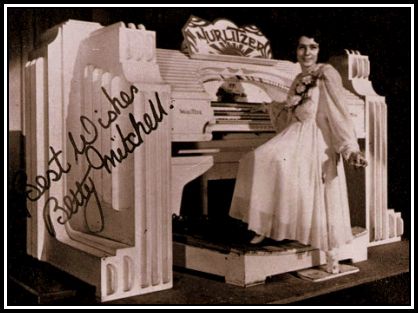 The Console of the Wurlitzer Organ of the Rex Cinema Coventry
The Console of the Wurlitzer Organ of the Rex Cinema Coventry
Another example of a special console with an exaggerated appearance was the one built for installation at the Leicester Square Theatre. Here, shell- or scallop-shaped surrounds were added to the organ.
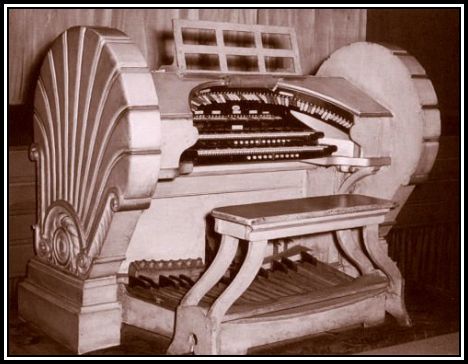 The Console of the Wurlitzer Organ of the Leicester Square Theatre
The Console of the Wurlitzer Organ of the Leicester Square Theatre
Although not otherwise strange in appearance, the console of the Wurlitzer Organ installed in the Ritz Cinema Workington was unique in that it was painted silver.
-oOo-
It is interesting to note that the majority of the consoles of Wurlitzer Organ installed in the U.K. were either of dark wood in colour or painted with either cream or white paint. In addition, gold trim was often added to them. The owners of the consoles in the U.S. were much more adventurous that those in the U.K. American consoles were often more likely to be brightly coloured – gold, red etc – as well as in cream or white together with exaggerated and detailed artwork.
Photograph of Miss Rosa Rio (1910-2010) at the centre
Click here to hear various bits of interviews with Miss Rosa Rio over the years
-oOo-
One, or rather two of the most famous of all black consoles are at Radio City Music Hall where two Wurlitzer Organs are installed. Another Wurlitzer Organ with a black console was at the Organ Stop Pizza Parlour in Mesa, Arizona. In contrast to organ consoles installed in the U.S., those in the U.K. were more conservative. There were no red or black consoles here, that is, until recently.
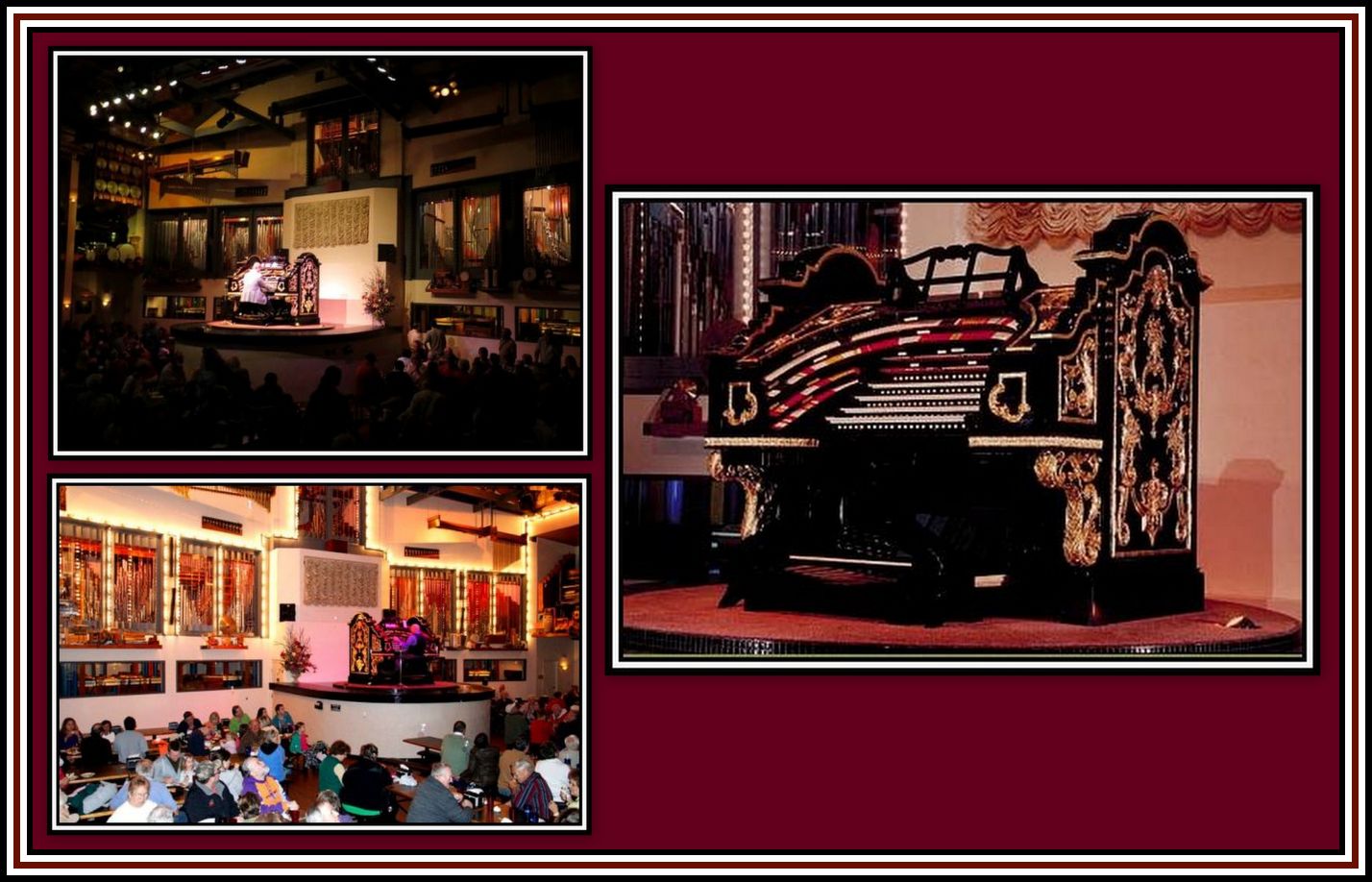 The Organ Stop Pizza Parlor & Wurlitzer Organ in 1999 – the largest Wurlitzer Organ in the world
The Organ Stop Pizza Parlor & Wurlitzer Organ in 1999 – the largest Wurlitzer Organ in the world
Click here to hear the Organ Stop Pizza Parlor Wurlitzer Organ played
With the adding of additional ranks to the Wurlitzer Organ of the Organ Stop Pizza Parlor in Mesa, the number of stops required on the console out-grew the space available to accommodate their number. It was decided that a new and larger console should be built to house all of the stops and that the original console be put up for sale.
The console was brought to the U.K. and used in the assembly of what is now known as the East Sussex National Wurlitzer (ESN). This organ was built using a variety of pipework that was also brought from the U.S.
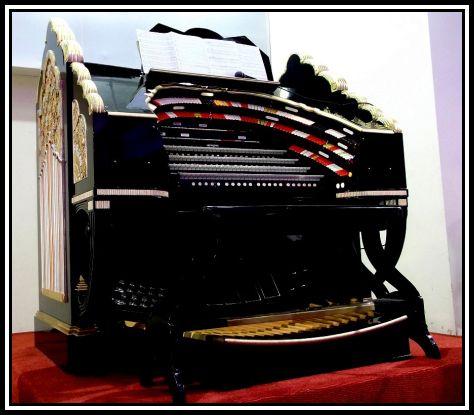 The First Black Coloured Wurlitzer Organ Console in the U.K.
The First Black Coloured Wurlitzer Organ Console in the U.K.
The ESN was installed at the East Sussex Golf Resort in a large conference/banquet area with an especially built area to accommodate the 32-foot pipes that are part of the variety of ranks of the organ.
The ESN organ was officially opened in April 2012 in a concert featuring Resident Organist Michael Wooldridge and guest organist, Richard Hills. At present, it is the largest Wurlitzer Theatre Organ installed in Europe and is played regularly at dances and concerts throughout the year and is Britain’s only black console.
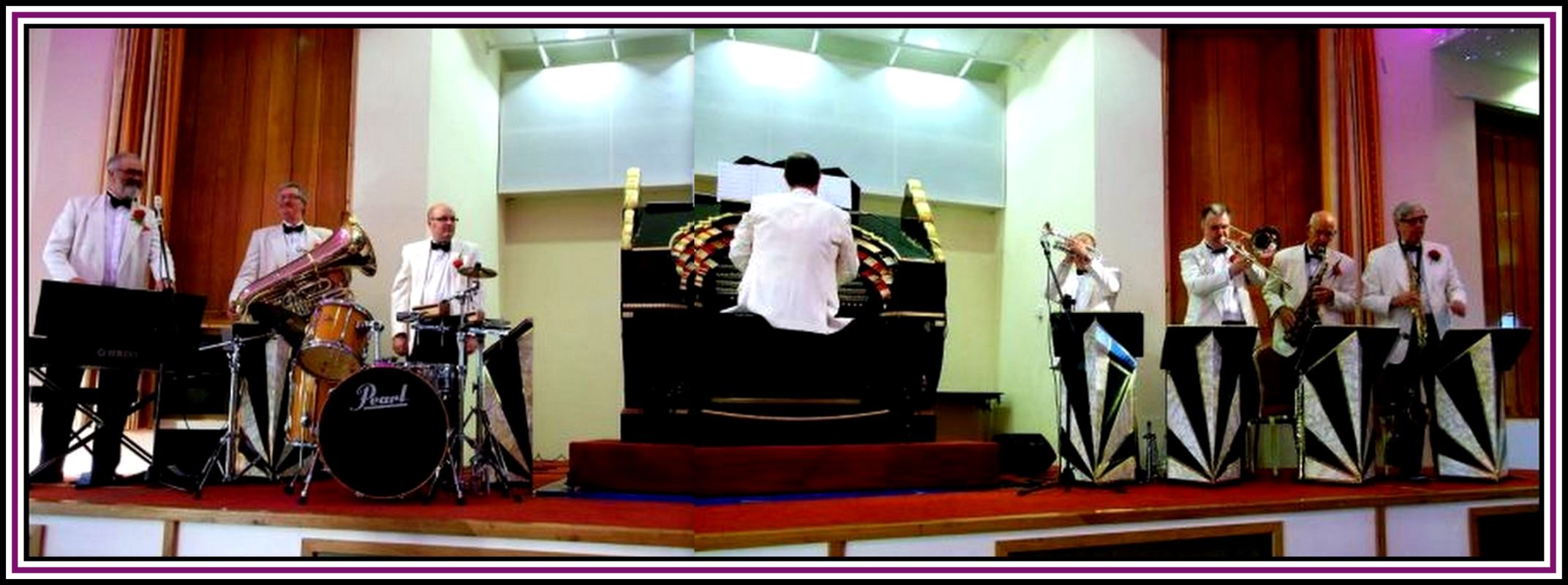 The Foxtrot Serenaders accompanying Michael Wooldridge at the ESN Wurlitzer Organ at a Concert
The Foxtrot Serenaders accompanying Michael Wooldridge at the ESN Wurlitzer Organ at a Concert
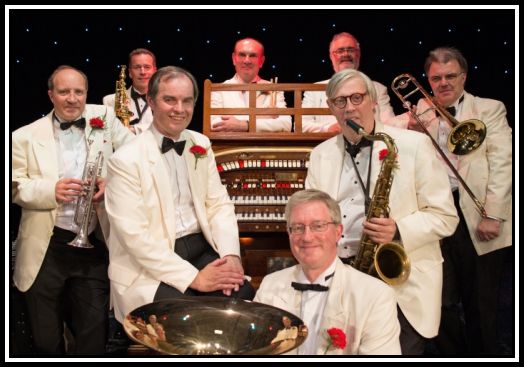 Michael Wooldridge & The Foxtrot Serenaders
Michael Wooldridge & The Foxtrot Serenaders
——-ooOOOoo——-
The Organist, Andrew Gilbert, wrote to say:
This page is an interesting read as always. It is great to see those consoles, a few of which I’ve had the pleasure to play – the 4-14 at the Gaumont State Kilburn was a gem, though the delay between pressing a key and hearing the sound was horrendous. My old organ mentor and veteran U.K. theatre organist Jackie Brown, insisted I go up and play it. “If you can handle that delay, you can handle anything”, he said. He suggested that I try to play it with the console lowered and facing the ‘wrong’ way. With a bit of work, I found that I could. By my second or third visit, I was very comfortable with it.
I don’t know if I ever sent you this photo, but this is an 18 year old Andrew Gilbert at the console at the Gaumont State Kilburn for a private concert – my girlfriend’s father worked for the cinema group and pulled a few strings for that one! It was also nice to hear a few of my friends in action too.
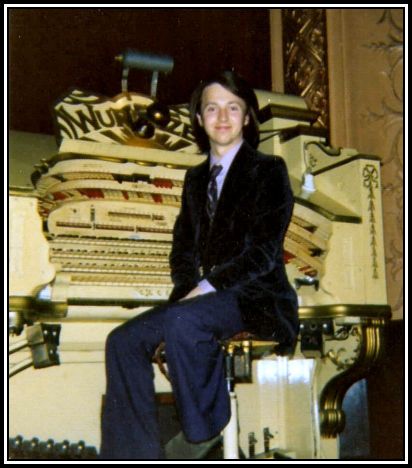 Andrew Gilbert at the console of the Wurlitzer Organ of the Gaumont State Kilburn. This photograph was taken by Ms Andrea Easton Gilbert
Andrew Gilbert at the console of the Wurlitzer Organ of the Gaumont State Kilburn. This photograph was taken by Ms Andrea Easton Gilbert
——-ooOOOoo——-
Click here to go to
PAGE FOUR of PART TWO:
WURLITZER ORGANS IN SCOTLAND
——-oooOOOooo——-
ACKNOWLEDGEMENTS
I would like to thank Mr. David Allfred of The Lancastrian Theatre Organ Trust for his kindness and help, to Mr. Andrew Gilbert and all others that helped produce this page.
I would also like to thank Mr. Stephen Dutfield for his impute.
——-oooOOOooo——-
Click here to go to PAGE FOUR of PART TWO: WURLITZER ORGANS IN SCOTLAND
——oooOOOooo——
——oooOOOooo——
Click here to return to PAGE ONE of PART TWO: INTRODUCTION & THE BUILDER OF THE MIGHTY WURLITZER
——oooOOOooo——
Click here to return to PART ONE: INTRODUCTION
——oooOOOooo——
Click here to return to the GLOSSARY
——oooOOOooo——
Click here to return to the THEATRE ORGANS HOME PAGE
——oooOOOooo——
Click here to return to the TABLE OF CONTENTS
——oooOOOooo——

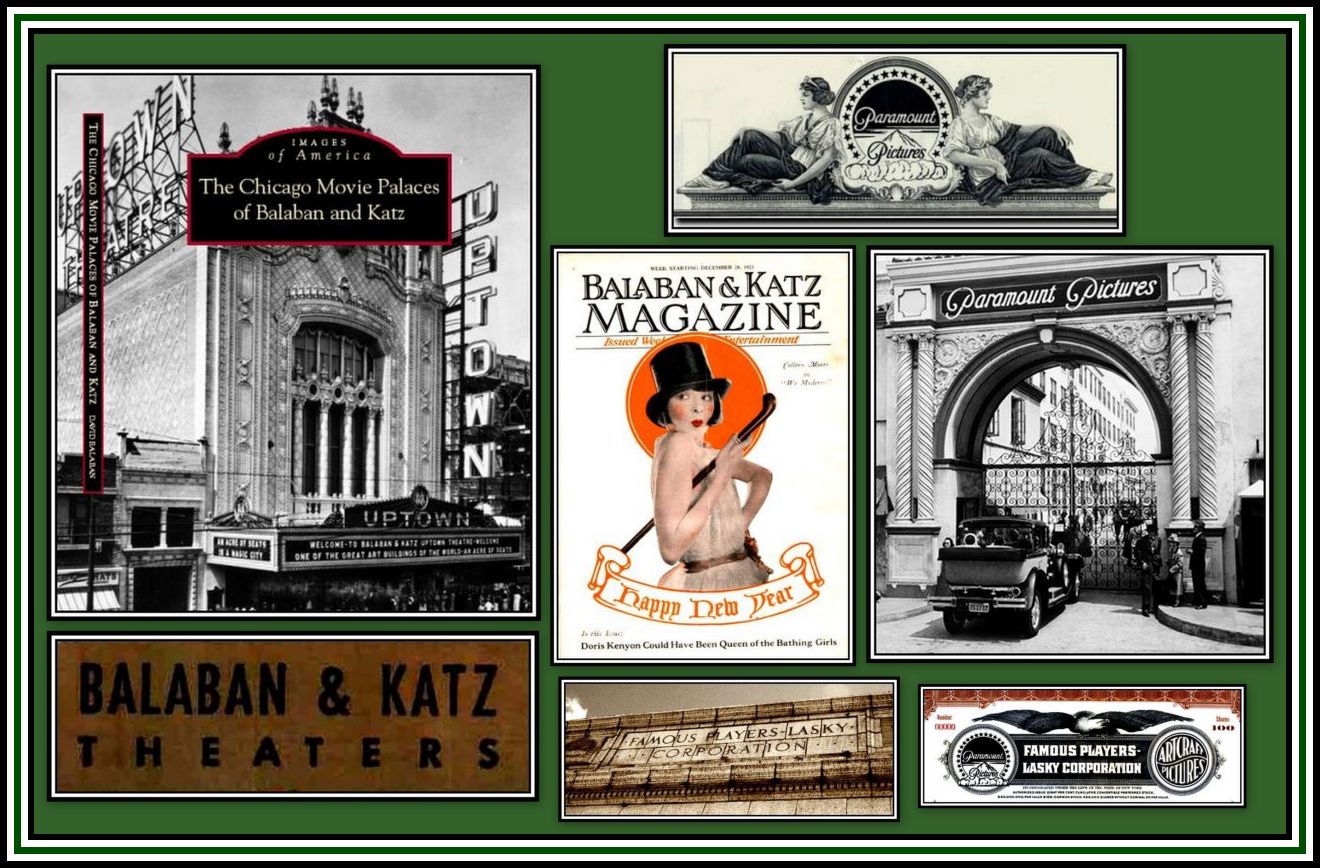
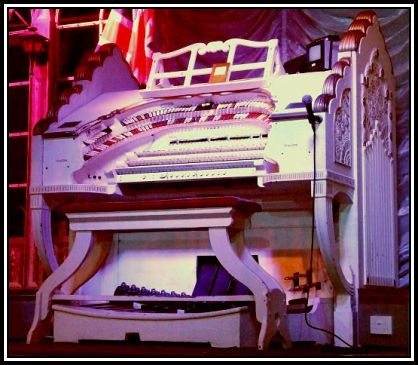


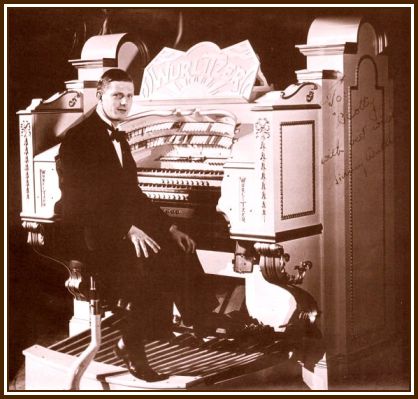
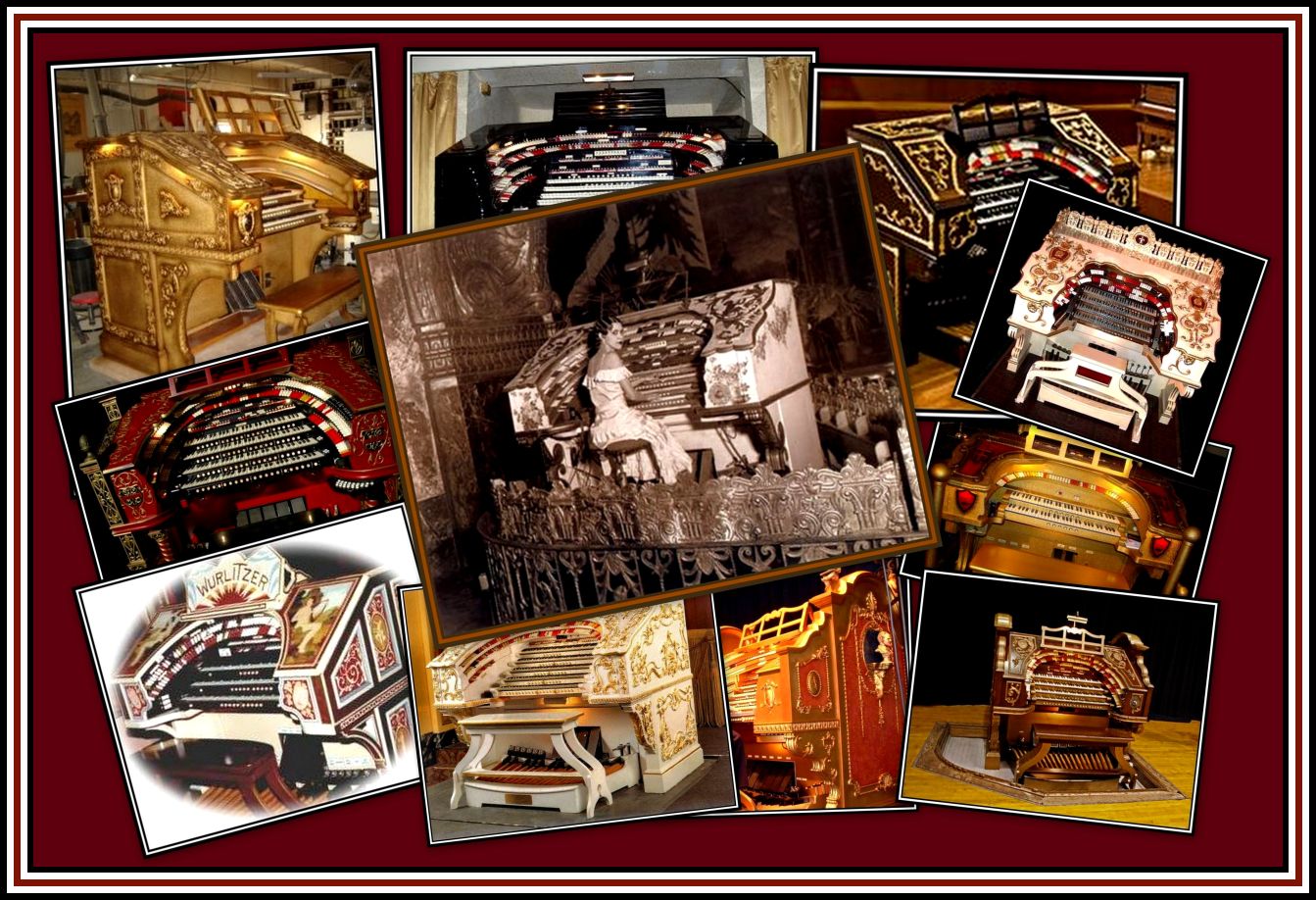
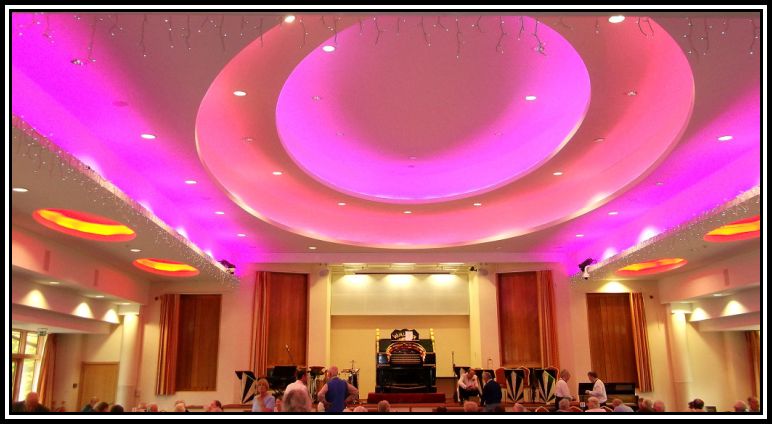
Picture of Len Rawle is not the ex granda Welling Woking Wurlitzer but the ex Trocadero elephant and caste Wurlitzer when it was installed in the southbank university. Now at the Troxy Stepney.
Great side!
Thank you for correcting my error. Charles
Mr. Beckingham: Thanks for your correction. Suitable changes have been made to correct my error.